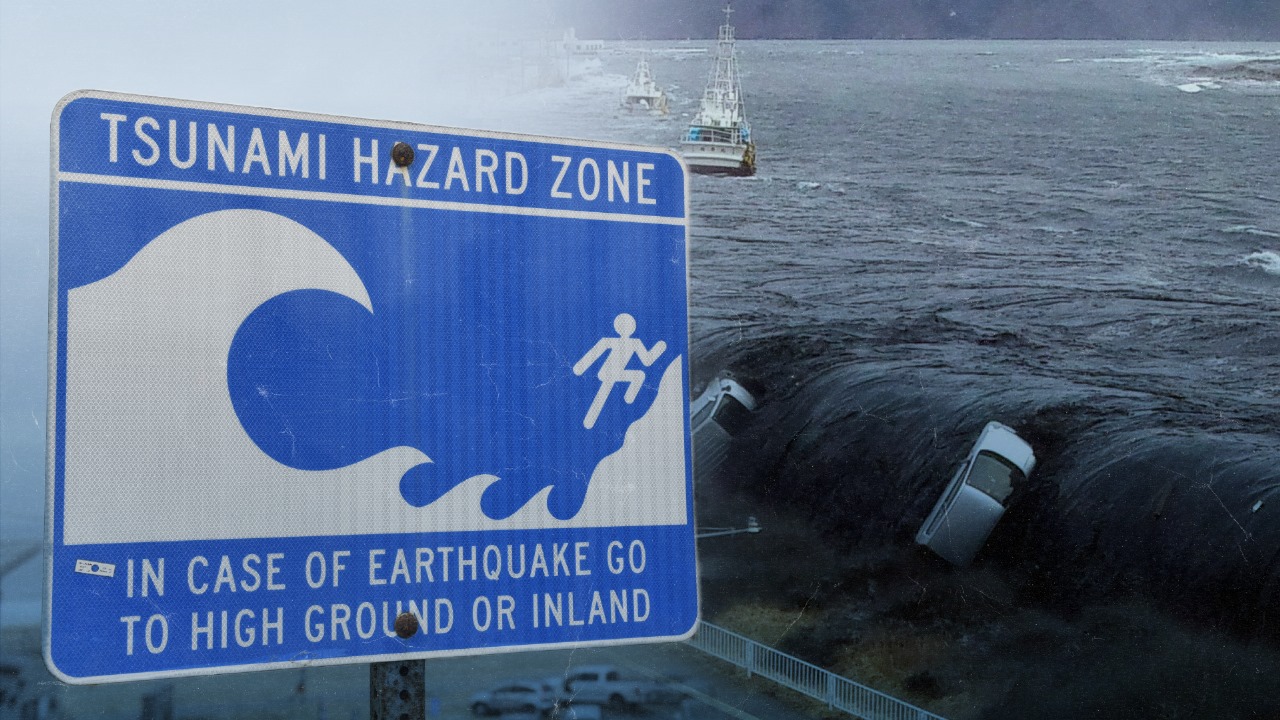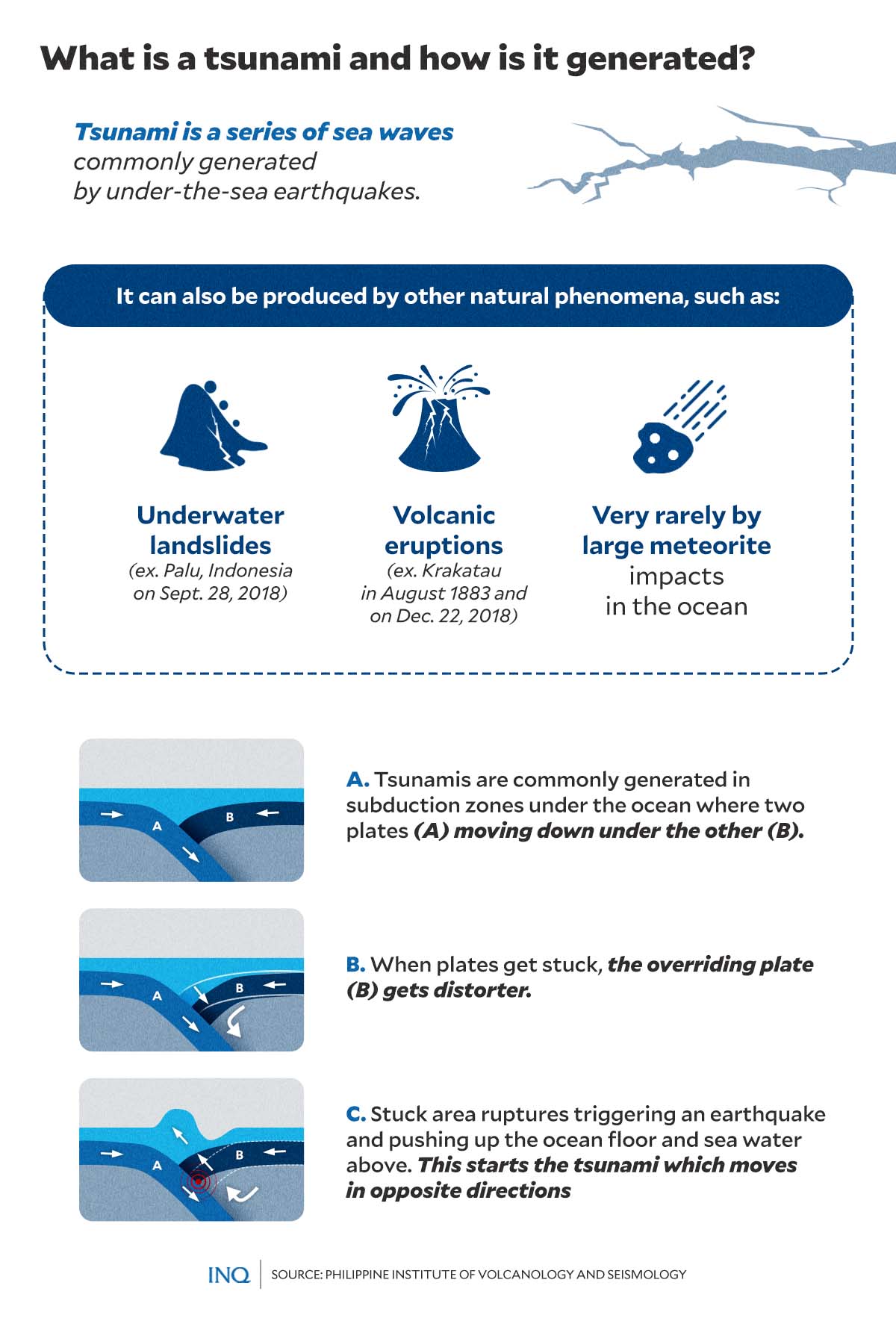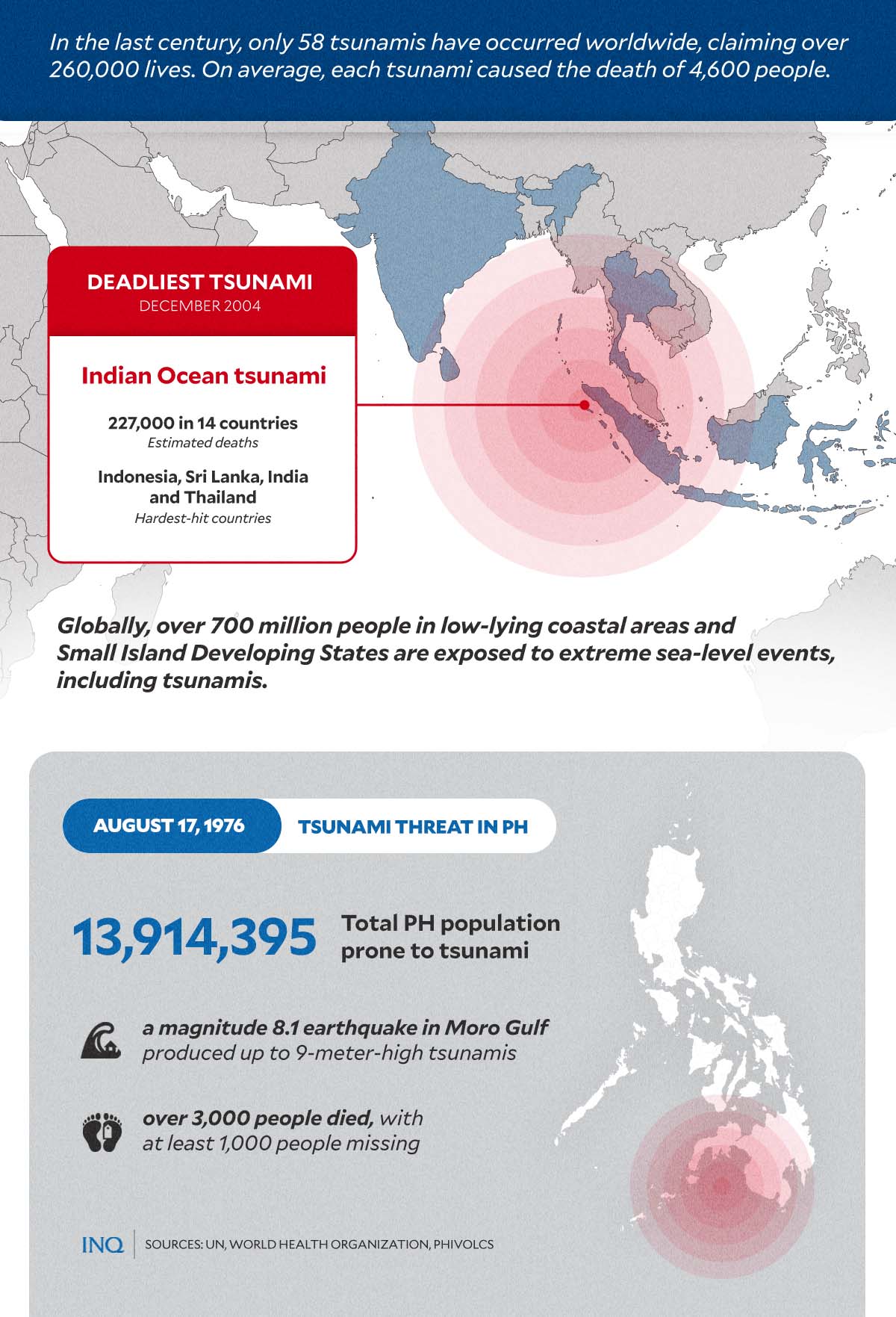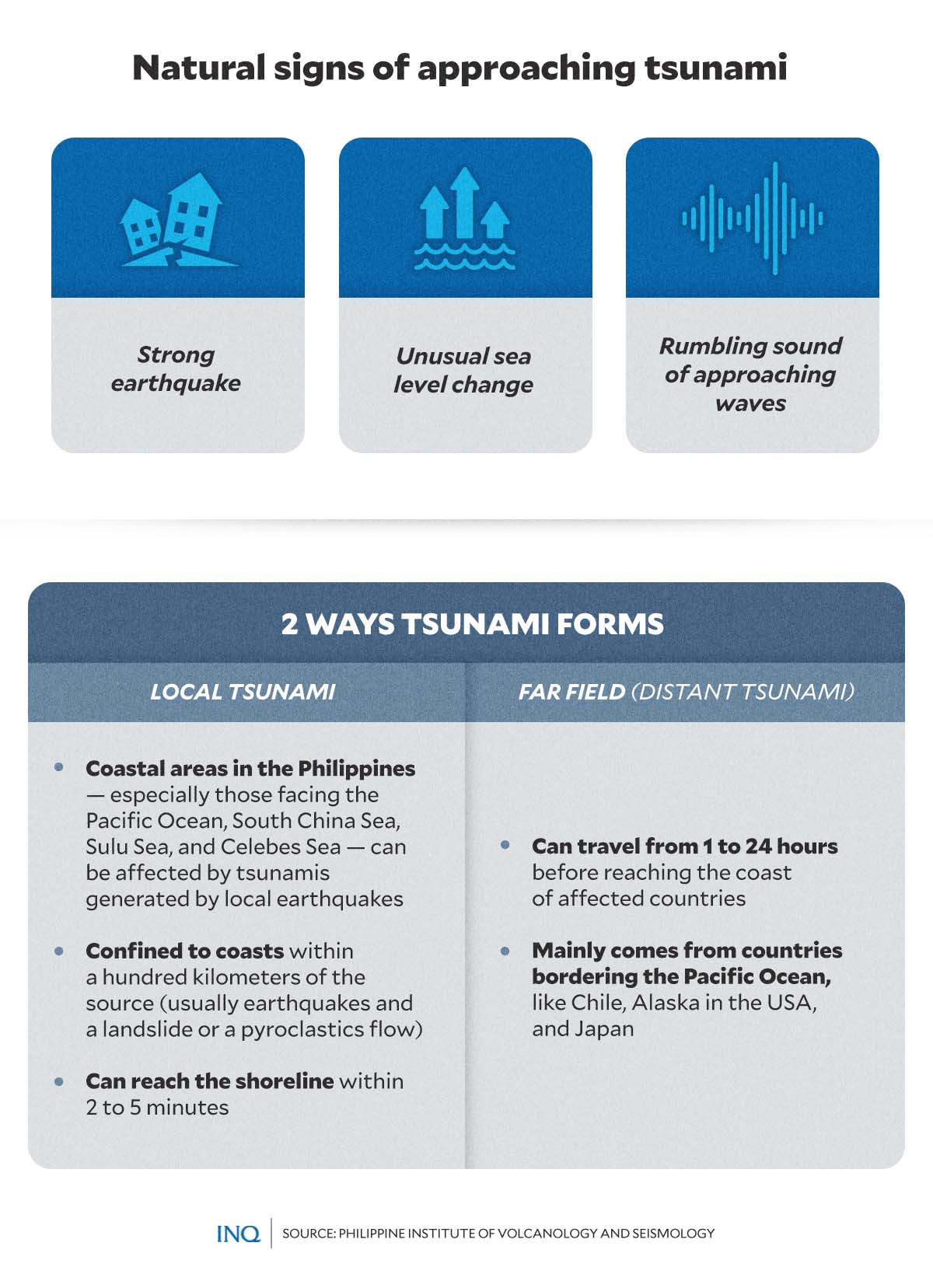World Tsunami Awareness Day: reminder of a deadly phenomenon

MANILA, Philippines—On World Tsunami Awareness Day, the public is reminded that while tsunamis may be rare, they are among the world’s most devastating natural hazards that have killed hundreds of thousands of people.
The United Nations (UN) General Assembly declared November 5th of every year as World Tsunami Awareness Day in December 2015 — reminding countries, international organizations, and civil society of the need to raise awareness about tsunamis and share effective approaches to reduce the risks they pose.
“World Tsunami Awareness Day was the brainchild of Japan, which due to its repeated, bitter experience has, over the years, built up major expertise in areas such as tsunami early warning, public action, and building back better after a disaster to reduce future impacts,” UN explained.
What is it, how does it happen?
According to UN, the word “tsunami” is from the Japanese words “tsu” — which means harbor — and “nami” — which means wave. A tsunami is a series of large ocean waves caused by earthquakes or other underwater disturbances.
However, UN clarified that not all earthquakes can lead to a tsunami. There are four conditions that must be met for an earthquake to cause a tsunami, namely:
- The earthquake must occur beneath the ocean or cause material to slide into the ocean.
- The earthquake must be strong, at least magnitude6.5 on the Richter Scale
- The earthquake must rupture the Earth’s surface, and it must occur at shallow depth – less than 70km below the surface of the Earth.
- The earthquake must cause vertical movement of the sea floor (up to several meters).
While tsunamis are usually caused by under-the-sea earthquakes, the Philippine Institute of Volcanology and Seismology (Phivolcs) noted that other natural phenomena such as underwater landslides, volcanic eruptions, and — although very rarely — meteorite impacts in the ocean can cause tsunami.
Article continues after this advertisementREAD: What Philippines can learn from Indonesia disaster
Rare but deadly
Tsunamis occur infrequently, but when they do, they can devastate coastal communities, displace many people, and claim countless lives due to the giant waves they create and the debris they sweep along which makes them deadlier
Article continues after this advertisementData from the United Nations reveals that in the past century, 58 tsunamis occurred globally, resulting in the deaths of over 260,000 people. On average, each tsunami has claimed the lives of 4,600 people — more than any other natural hazard.
The deadliest tsunami that has ever occurred, according to UN, was the Indian Ocean tsunami in December 2004. An estimated 227,000 people across 14 countries died as a result.

UN noted that coastal communities, specifically those that are often concentrated in low-lying and highly populated areas, are the most potentially vulnerable to coastal hazards such as tsunamis.
“Globally, over 700 million people in low-lying coastal areas and Small Island Developing States are exposed to extreme sea-level events, including tsunamis,” the World Health Organization previously said.
Meanwhile, according to Phivolcs, the Philippines is vulnerable to tsunamis “due to the presence of offshore faults and trenches such as Manila Trench, Negros Trench, Sulu Trench, Cotabato Trench, Philippine Trench, and East Luzon Trough.”
The most disastrous tsunami that has hit the Philippines in the last decades occurred on August 17, 1976, when a magnitude 8.1 earthquake in Moro Gulf produced up to a 9-meter-high tsunami.
The tsunami devastated the southwest coast of Mindanao and left over 3,000 people dead, with at least 1,000 people missing.
A recent analysis of data from Phivolcs and the Philippine Statistics Authority (PSA) showed that around 13 million people in the country are prone to tsunamis.
READ: NDRRMC holds Q4 nationwide earthquake drill
Safety and preparedness
Tsunamis can be deadly but UN believes they needn’t be.
“Early warning and early action are effective tools to protect people, saving lives, and preventing the hazard from becoming a disaster. To be effective, tsunami early-warning systems must cover every at-risk person, they must be multi-hazard, and communities must be prepared so they can act quickly,” UN explained.
Last year, the United Nations Office for Disaster Risk Reduction (UNDRR) launched the #GetToHighGround campaign to promote awareness about reducing the risk of tsunamis.
The campaign encourages citizens to participate in drills, runs, or walks along tsunami evacuation routes, which helps communities prepare for natural disasters and build their resilience.

Phivolcs has identified three natural signs that indicate the approach of a tsunami. These are:
- a strong earthquake;
- unusual sea level change; and
- rumbling sound of approaching waves.
The government agency stressed that everyone in the community should learn the following important Tsunami Safety and Preparedness Measures:
- Do not stay in low-lying coastal areas after a felt earthquake. Move to higher grounds immediately.
- If unusual sea conditions like rapid lowering of sea level are observed, immediately move towards high grounds.
- Never go down the beach to watch for a tsunami. When you see the wave, you are too close to escape it.
- During the retreat of sea level, interesting sights are often revealed. Fishes may be stranded on dry land, thereby attracting people to collect them. Also, sandbars and coral flats may be exposed. These scenes tempt people to flock to the shoreline, thereby increasing the number of people at risk.
Fighting inequality
This year’s World Tsunami Awareness Day theme is “Fighting Inequality for a Resilient Future,” which mirrors the subject highlighted during the International Day for Disaster Reduction.
“The activities during this observance aim to explore the relationship between tsunamis and inequality,” UN said.
“Specifically, they focus on how inequality can make tsunamis more dangerous for certain populations and how the aftermath of a tsunami can drive vulnerable people further into poverty, thus worsening inequality,” it added.

It added that this year’s World Tsunami Awareness Day activities will focus on raising awareness about the underlying disaster risk drivers – poverty, inequality, and vulnerability – that make tsunamis deadlier for those most at risk.
“Tsunamis pose a significant threat to all of us, but they are particularly dangerous for certain groups of people, such as women, children, people with disabilities, and older persons,” said UN.
“Inequality creates the conditions that lead people to become exposed and vulnerable to disasters, such as tsunamis. The poorest and most at-risk are disproportionately impacted, thus furthering inequality,” it added.
Reducing vulnerability would require addressing poverty, exposure, and vulnerability, the organization continued.